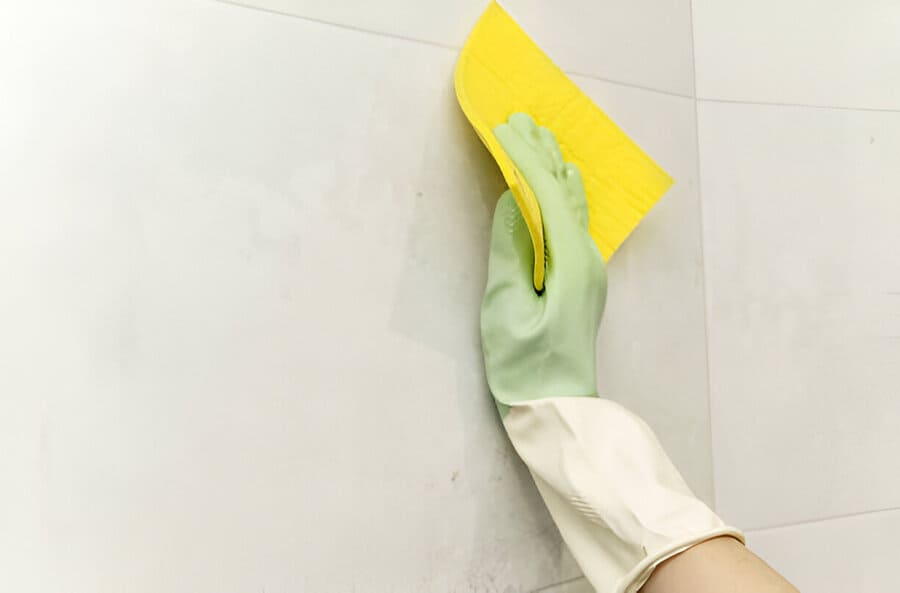
Stains on bathroom tiles are commonplace. Murky bathroom floors not only seem drab and unpleasant at a glance, but they also mar the entire place, making it appear unclean and unhygienic. Despite our constant efforts in scrubbing, some stubborn stains are hard to go by. They remain constant and unmovable. But what if I tell you that cleaning dirty tiles doesn’t need hours of scrubbing or expensive cleaners? This article provides a step-by-step guide to making your bathroom tiles stain-free and sustaining cleanliness.
Some of the common stains affecting bathroom tiles are hard water stains and soap scum. The following are the types of stains that transpire more often.
Water stains: Minerals like calcium and magnesium, present in hard water, accrue on the surface and form a white or yellowish deposit known as limescale. Water deposits and spills, typically hard water, can leave murky patches and persistent stains on the bathroom tiles.
Mildew or mold: Mildew and mold thrive in damp situations. Did you notice the green, pink, or black patches in your bathroom? That is mold. Hence, bathrooms and kitchens are places that get affected in such instances. Not only does mold look bad on the tiles, but it is also harmful to your health. If mold is budding in your bathroom, you must get rid of it immediately.
Soap scum: Bathroom tiles often accumulate scum left behind by soaps, shampoo, and body wash mixed with hard water. These stains can be easily removed by cleaning with a solution of water and vinegar.
Grout stains: Over time, spills, dirt, and dust build up in the grout used to fill the spaces between tiles. Since the grout is porous accumulates dirt and debris.
Rust stains: These reddish-brown colored tints are tough to take away. Metallic cans, old pipes, and fixtures often leave rust deposits on the tiles surface.
Chemical stains: Tiles lose their natural sheen and get discolored because of the extended use of harsh cleaning agents. Usually, chemical damage is permanent . If the tiles are damaged by chemicals, they will need to replaced. how to clean discolored tile
Before initiating the cleaning procedure, preparing your tools will help you save time and effort.
To clean bathroom stains, you would need the items stated below.
As cleaning agents, you will need:
For eliminating stubborn stains on the floor, you would need more strong cleaning agents, such as:
Read our blog on How To Remove Bleach Stains from Tiles
Stubborn stains accumulate over time on bathroom tiles, making them lose their gleam as initially found on them. With the appropriate technique, you can reinstate their old shine. This step-by-step guide offers active methods for stain removal.
Treat the local spots: Get rid of the stubborn spots and mold build-ups before heading forward with the deep cleaning process. This can be easily done by preparing a solution of white vinegar and water. Start by filling out a spray bottle. Include half vinegar and half water, and spray the affected areas for spot cleaning.
Wall cleaning: Bathroom walls may also have grime and grease build-up over time. To clean, mix some baking soda with lime and a bucket of warm water. These natural ingredients will effectively clean mold and discoloration. For more efficient cleaning, use chemical cleaning agents, such as FilaNO RUST Stain Remover, and scrub the surface with a wet sponge.
Clean floor tiles: Start the course of cleaning the floor by vacuuming or sweeping, particularly the corners. Once completed, scrub the floor with commercial cleaners. Once done, the next step will be to sanitize it with a decontaminator to eliminate bacteria.
Cleaning the grout: The grout easily collects grime and water, ensnaring the microorganisms and microbes. The area between the tiles is particularly challenging to tackle. To clean the grout, prepare a solution of vinegar and water in a 50:50 ratio and methodically drench the area. Scrub the area with an old toothbrush and rinse thoroughly. For advanced cleaning, use a cleaning agent.
It is vital to create a steady or weekly cleaning routine to thwart dirt and mold build-up. Remember, an unhygienic bathroom poses severe health hazards.
Maintaining a clean bathroom should not be that problematic. All you need is to be both particular and prudent with your cleaning schedule. Steady upkeep and maintenance go a long way in sustaining hygiene and bathroom aesthetics. Furthermore, consistent cleaning can help you evade the need for deep cleaning, which is onerous.
Follow the tips discussed below to keep a bathroom clean:
With FilaNo Rust Stain Remover, you can now confirm a sparkling clean bathroom and eliminate stains with ease. If you are looking for a comprehensive cleaning solution for your bathroom tile, consider investing in FilaNO RUST Stain Remover without hesitation.
This progressive merchandise proves advantageous in eliminating most stubborn stains and comes with a non-acidic formula. FilaNo Rust Stain Remover has a gel-like consistency. Natural stone, terrazzo, porcelain, terracotta, marble, granite, and concrete -whatever your tile type may be, this product can be ideally used on various types of tiles. It is appropriate for honing delicate marble tiles. The product features a distinct formula that is free from harsh chemicals and gentle on both the skin and the planet.

Welcome to Tile Pro Depot! We established this site to service the specific needs of the tile installation professional. Tile installation tools, tile setting materials, premixed grout and more tile installation products online at Tile Pro Depot.